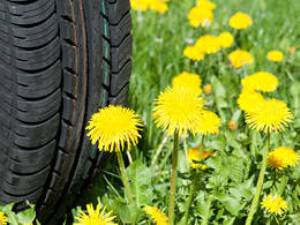Apr 29 2015
A research team has identified special proteins in the white milky fluid of dandelion plants, specifically the Russian dandelion, Taraxacum kok-saghyz, that play a vital role in the formation of rubber in the plant.
 Rubber from dandelions - Photo: Ulrich Benz / TUM
Rubber from dandelions - Photo: Ulrich Benz / TUM
The dandelions’ milky fluid, which contains the rubber, is produced in special cells. The biosynthesis of rubber occurs due to a protein complex situated on the surface of “rubber particles”. These particles are enclosed by a protective coating, and contain polyisoprene, which is the key component of rubber.
This research was done in partnership with scientists from Münster University, the Münster branch of the Fraunhofer Institute for Molecular Biology and Applied Ecology IME, the Technische Universität München (TUM) and TRM Ltd. (York, UK). They chose the Russian dandelion, Taraxacum kok-saghyz, for their study, and found it contains a special protein, referred to as rubber transferase activator, whcih plays a vital role. If this protein is not present in the plant, then rubber cannot be formed. Therefore, the scientists believe that the protein is needed for the creation of the rubber-producing protein complex. Their findings have been published in the current online issue of the journal "Nature Plants".
In other research, conducted with inputs from IME and Münster University, a more significant protein has been identified, which assists in the development of long polyisoprene chains. These polymer chains are crucial as they provide the rubber with its elasticity and resilience.
The research collaboration between Munich and Münster is a well-established one. "First we have contributed by labeling studies using stable isotopes to investigate the metabolic pathways for latex production," says Professor Wolfgang Eisenreich, biochemist at the TU München. Their contribution to the publication was that they characterized the polyisoprene on the basis of NMR spectroscopic measurements.
"Dandelions have become well-known recently in particular as a result of applied research," explains head of research Dr. Christian Schulze Gronover (IME, Münster branch). "Now we are pleased to have some news again from the field of basic research: we have been able to identify no fewer than two key components of rubber biosynthesis."
Manufacture of rubber using biotechnology has not been achieved until now. However, now that key components required in rubber synthesis have been identified, we are a step closer to processing rubber from these plants.
Going forward, dandelion plants that do not produce rubber can be tested in laboratory experiments to test the role of rubber in the plants. One theory up for discussion is that it offers defense against pathogenic agents.
Dirk Prüfer, Professor of the Biotechnology of Plants at Münster University and head of the Functional and Applied Genomics department at the IME in Münster, points out: "We achieved these research results only through effective collaboration, through the intelligent linking of basic and applications-oriented research. We hope to expand this successful model further."
The research was supported by the German Federal Environmental Foundation (DBU) and the German Federal Ministry of Food and Agriculture.